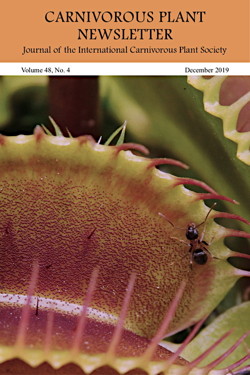International Carnivorous Plant Society
Carnivorous Plant Newsletter Archive
Quinone patterns and identification of Japanese Spider Leg Sundews (Drosera Sect. Arachnopus)
Jan Schlauer and Siegfried R. H. Hartmeyer and Irmgard Hartmeyer
Carniv. Pl. Newslett. 48(4):161-163
Published 8 November 2019
https://doi.org/10.55360/cpn484.js448
Summary
Keywords: Japanese Spider Leg Sundews, Drosera, Phytochemistry, Naphthoquinones, Chemotaxonomy
Article Citation
Jan Schlauer and Siegfried R. H. Hartmeyer and Irmgard Hartmeyer. 2019. Quinone patterns and identification of Japanese Spider Leg Sundews (Drosera Sect. Arachnopus). Carniv. Pl. Newslett. 48(4):161-163. https://doi.org/10.55360/cpn484.js448
Page views: 1141
©2025 International Carnivorous Plant Society
www.carnivorousplants.org
This page is maintained by John Brittnacher.
Please contact us at our membership website, icps.clubexpress.com.
Privacy: The Carnivorous Plant Newsletter Archive website does not track users.

